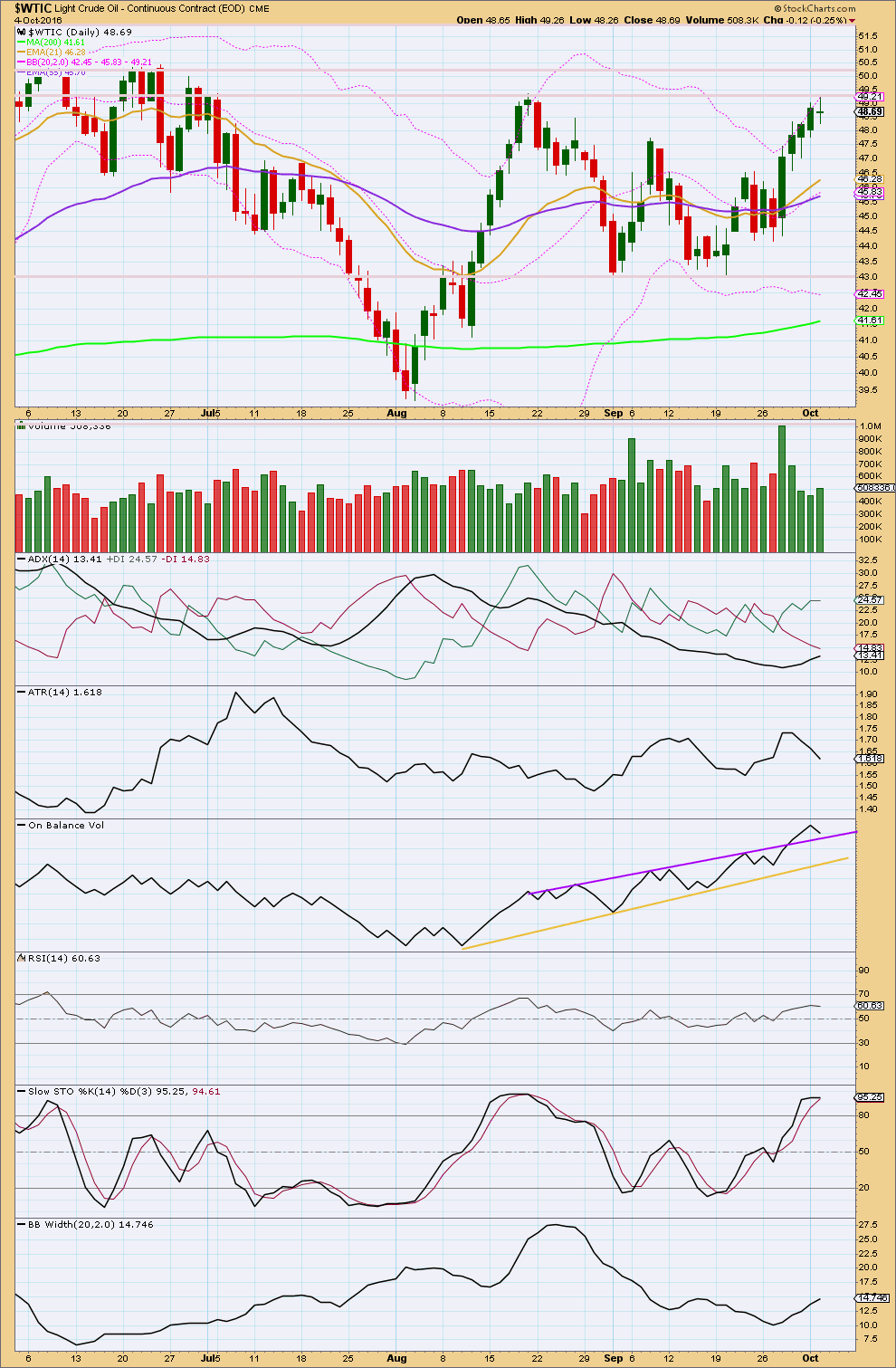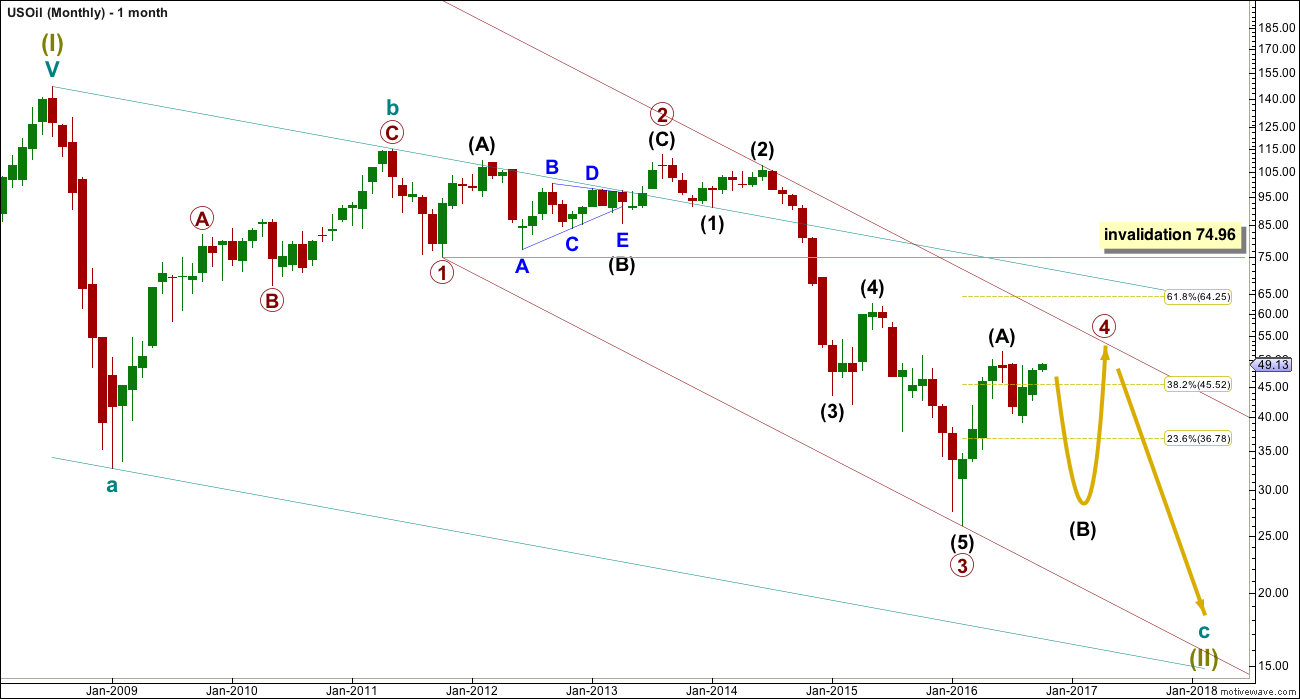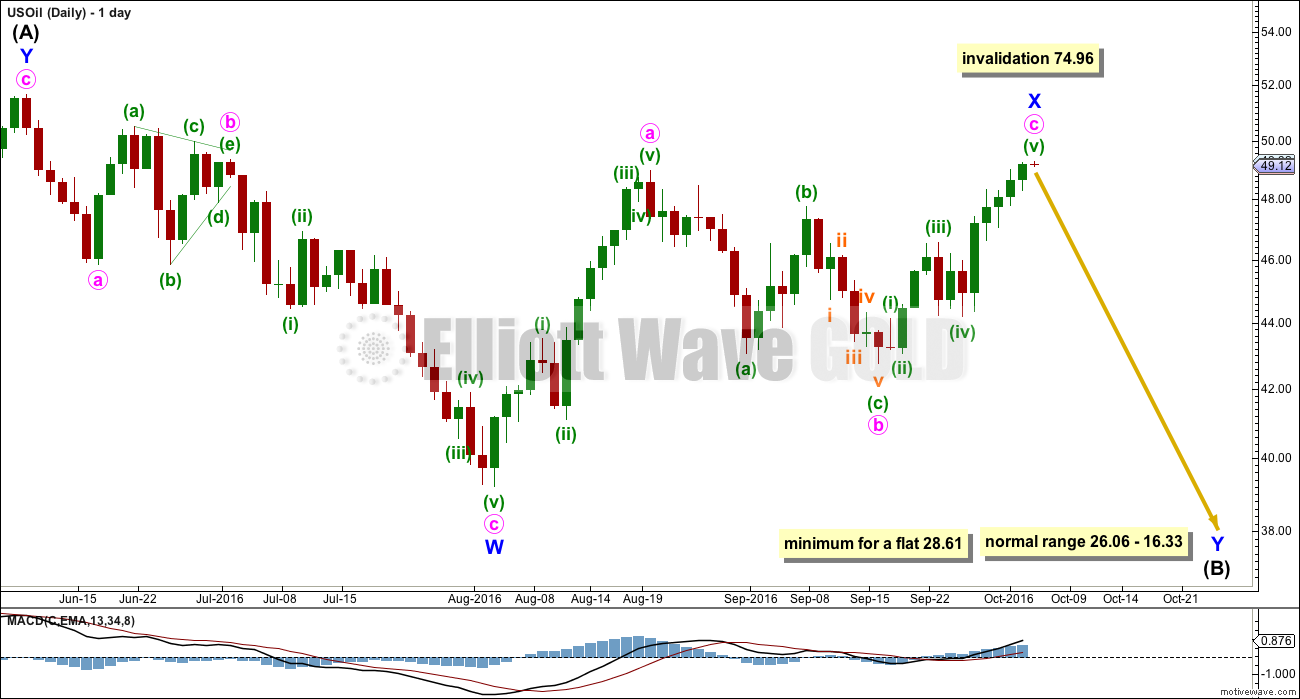With price consolidating and the Elliott wave count in either a B or an X wave, classic technical analysis may be a better guide to what Oil may do next.
Summary: Support and resistance suggest a downwards swing from about here to end only when price finds support about 43 and Stochastics is oversold. The Elliott wave counts see price in either an X or B wave, so there are too many structural possibilities for any Elliott wave count to have any reasonable reliability at this stage.
New updates to this analysis are in bold.
MONTHLY ELLIOTT WAVE COUNT
Within the bear market, cycle wave b is seen as ending in May 2011. Thereafter, a five wave structure downwards for cycle wave c begins.
Primary wave 1 is a short impulse lasting five months. Primary wave 2 is a very deep 0.94 zigzag lasting 22 months. Primary wave 3 is a complete impulse with no Fibonacci ratio to primary wave 1. It lasted 30 months.
Primary wave 4 is likely to exhibit alternation with primary wave 2. Primary wave 4 is most likely to be a flat, combination or triangle. Within all of these types of structures, the first movement subdivides as a three.
Primary wave 4 is likely to end within the price territory of the fourth wave of one lesser degree; intermediate wave (4) has its range from 42.03 to 62.58.
Primary wave 4 may end if price comes up to touch the upper edge of the maroon channel. The upper edge of this channel has been pushed up to sit on the end of intermediate wave (2) within primary wave 3.
Primary wave 4 is most likely to be shallow to exhibit alternation in depth with primary wave 2. So far it has passed the 0.382 Fibonacci ratio at 45.52. It may now continue to move mostly sideways in a large range.
Primary wave 4 may not move into primary wave 1 price territory above 74.96.
DAILY ELLIOTT WAVE COUNT
Intermediate wave (A) may be complete as a double zigzag.
If intermediate wave (A) is a three, then intermediate wave (B) is most likely to be a very deep correction. It may make a new low below the start of intermediate wave (A) at 26.06.
If primary wave 4 is to be a flat correction, then intermediate wave (B) must be a minimum 0.9 length of intermediate wave (A) at 28.61. The normal range for intermediate wave (B) would be 1 to 1.38 the length of intermediate wave (A) at 26.06 to 16.33.
If primary wave 4 is to be an expanded flat correction, then intermediate wave (B) should be 1.05 the length of intermediate wave (A) or longer, at 24.78.
If primary wave 4 is to be a triangle, then intermediate wave (B) has no minimum nor maximum. It must only subdivide as a three wave structure. It may make a new low below the start of intermediate wave (A) at 26.06 as in a running triangle. A normal range for intermediate wave (B) within a larger triangle would be 0.8 the length of intermediate wave (A) at 31.18.
A new alternate daily wave count below looks at possible subdivisions for an unfolding triangle.
Primary wave 4 may not move into primary wave 1 price territory above 74.96.
Intermediate wave (B) may be any of more than 23 possible corrective structures. It would most likely be a single or multiple zigzag in order to be a deep correction. It may also be an expanded flat to be deep.
This first wave count looks at intermediate wave (B) unfolding as a double zigzag.
Within double zigzags, the X wave is most often a brief and relatively shallow zigzag. Minor wave X may be close to completion, but it is no longer brief nor shallow. The probability of this main wave count has reduced this week and is now about even with the two alternates.
Within minor wave X, the structure of minute wave c may now be complete. Minute wave c is 0.49 longer than 0.618 the length of minute wave a.
Minor wave Y may unfold downwards towards the minimum required for intermediate wave (B).
ALTERNATE II DAILY ELLIOTT WAVE COUNT
If primary wave 4 is unfolding as a triangle, then only one sub-wave within it may unfold as a multiple. Because intermediate wave (A) upwards fits as a double zigzag, intermediate wave (B) of a triangle may not also be a multiple.
This new alternate looks at the possibility that intermediate wave (B) downwards is unfolding as a single zigzag. Minor wave A downwards will subdivide as a five wave structure.
Minor wave B may be a completed zigzag. Minute wave c has moved above the end of minute wave a avoiding a truncation.
Triangle sub-waves are commonly about 0.8 to 0.85 the length of the prior wave. One of the triangle sub-waves is often close to 0.618 the length of the prior wave. So far intermediate wave (B) has reached down to only 0.49 the length of intermediate wave (A). If primary wave 4 is unfolding as a triangle, it would be very unlikely that intermediate wave (B) is over at the low labeled minor wave A. It is much more likely to move lower, so that the triangle would have a more normal look.
Intermediate wave (B) would reach into normal range from 31.18 to 29.90 for a triangle.
ALTERNATE DAILY ELLIOTT WAVE COUNT
This alternate is identical to the first wave count up to the low labelled minor wave W.
It still sees intermediate wave (A) upwards as a complete three wave structure, a double zigzag.
Thereafter, it also still sees intermediate wave (B) downwards unfolding also as a double zigzag. This is possible if primary wave 4 is unfolding as a flat correction.
This alternate sees minor wave X as incomplete within the double zigzag of intermediate wave (B).
Minor wave X may be any corrective structure. It may be unfolding as a flat correction. This is a common structure, just less common than a simple zigzag.
Within the flat correction of minor wave X, minute wave b must retrace a minimum 0.9 length of minute wave a at 40.18. Minute wave b may be unfolding as an expanded flat correction. Minuette wave (b) may now be complete and is a 1.05 length of minuette wave (a). Minuette wave (c) must be a five wave structure downwards.
When minute wave b is complete and has reached the minimum, then a trend change for Oil would be expected for this alternate. Minute wave c upwards would be expected to make at least a slight new high above the end of minute wave a at 48.99 to avoid a truncation.
The longer term expectations for the end of intermediate wave (B) are exactly the same for both wave counts.
TECHNICAL ANALYSIS
DAILY CHART

Click chart to enlarge. Chart courtesy of StockCharts.com.
Oil is still range bound and this market is not trending. Resistance is about 49.30 and support is about 43.
During this consolidation, so far it is four upwards days which have strongest volume, suggesting the breakout when it comes is more likely to be upwards than downwards. As we have seen today with Gold, this technique often works (but often is not the same as always). A downwards breakout may yet occur.
Price needs to break above 49.30 or below 43 on a day with increased volume for a classic breakout to be indicated. After the breakout, it is likely that price may turn to test support or resistance before moving away from the consolidation area in a new trend.
Expect price to swing from resistance to support and back again while price remains within the consolidation zone, using Stochastics as a guide to when each swing ends and the next begins. At this stage, price is at resistance and Stochastcis is overbought. A downwards swing is likely about here, to continue until price reaches support and Stochastics is oversold.
Volume is overall declining for the last four upwards days indicating this upwards swing is unlikely to continue much further, as it lacks support from volume.
ADX is still below 15. ADX needs to be above 15 for a new trend to be indicated.
ATR is currently declining in agreement with ADX.
Bollinger Bands are fluctuating, with some increase for the last few days. These three indicators are not in agreement, but on balance it should be assumed that this market is not yet trending.
On Balance Volume gave a bullish signal with a break above resistance at the purple line. This line is reasonably long held and well tested, but it is relatively steep, so it does not hold strong technical significance. The signal is bullish but not strong. OBV may find some support now at the purple line. A break below this purple line would be a bearish signal. OBV may find support at the yellow line.
RSI is not extreme and exhibits no divergence at this high with price to indicate weakness.
This analysis is published @ 02:40 a.m. EST.





And this is the close up 4hr view. Looks like a trading top is expected soon.
As part of the free commodities videos this week, today Jeffrey Kennedy covered oil. This offers a slightly different view on the 4th wave in progress.
Is there an alternative count that suggest oil is going to $60 or more this year?
It’s is getting very hard to short this market base on wave count. Specially with oil inventories droping like a rock every single week.